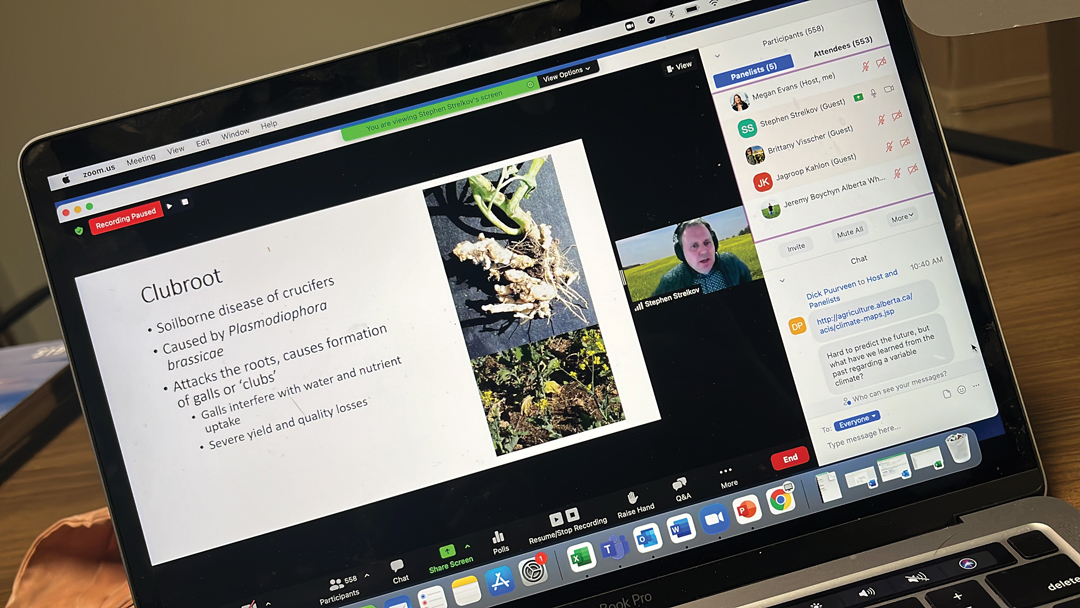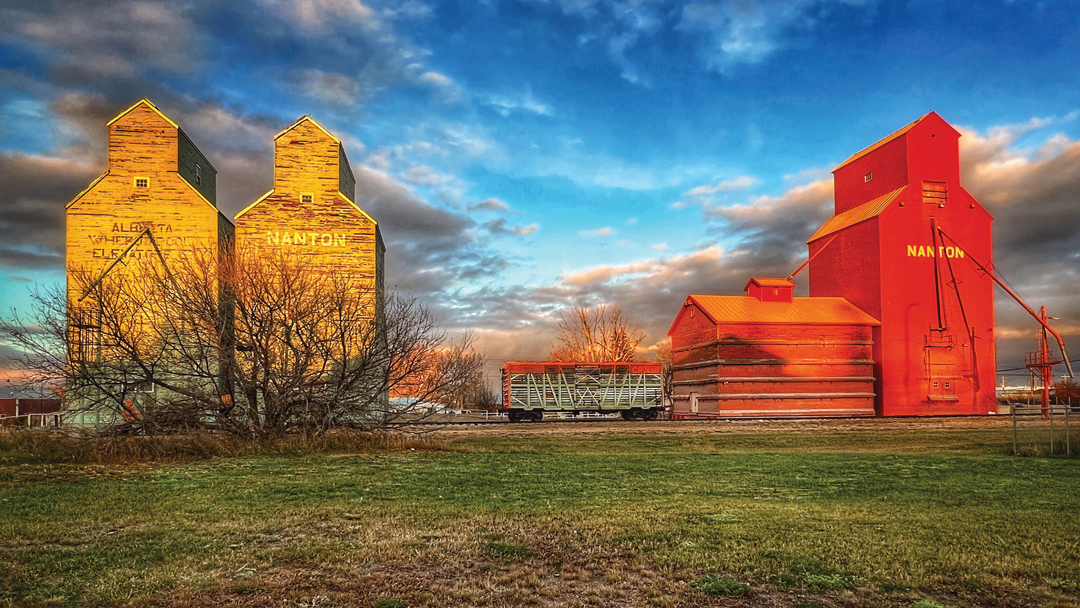AG ORGANIZATIONS SUPERSIZE THEIR VIRTUAL REACH
BY IAN DOIG • PHOTO BY MEGAN EVANS
Massive resources are poured into agricultural research. It’s the goal of industry organizations to present this rich body of fresh agronomic information alongside established knowledge and make it easy to understand for farmers and agronomists. This communication process is commonly referred to as “extension.”
“We’re constantly on the lookout for information that will help provide decision-making tools for farmers so they can be more effective and economic with crop production,” said Jeremy Boychyn, Alberta Wheat and Barley agronomy research extension specialist.
The pandemic interrupted the flow of extension information when it put in-person events such as field days, crop walks and regional farmer meetings on hold for two years. Government-funded extension became especially sparse.
Prior to this roadblock, ag organizations published YouTube videos, podcasts and held webinars, but uptake had its limits. According to a late 2019 pre-pandemic survey conducted by Sheri Strydhorst, Alberta Wheat and Barley’s agronomy research specialist, farmers’ most-trusted source of extension information was in-person presentations by scientists. “Farmers have a strong desire for third-party, independent perspective on products and practices,” she said. Second was crop walks and fact sheets. Farmers were more hesitant to rely upon virtual presentations, but this appears to have changed.
These new mediums took on much higher priority as pandemic restrictions ramped up in spring 2020. It became more difficult to keep farmers informed on best agronomic practices and new developments, said Boychyn. “That was the big thing. How do we provide this timely information so farmers can access it now and later?”
Ag organizations quickly supersized their virtual offerings. This required deliberation about how best to deliver information and assess the effectiveness of online engagement. Boychyn hosted the In the Field Webinar series, which featured guest experts who spoke on timely agronomic subjects. The 2020 growing season kicked off with presentations on early-season weed control, the value of in-crop nitrogen application and a rundown of the year’s planned Gateway Research Organization (GRO) field trials. These live, online sessions allowed viewers to ask questions or to watch the archived webinars on the commissions’ website. Boychyn noted farmers are an entrepreneurial, knowledge-seeking group and had more opportunity and desire to attend webinars or listen to podcasts. This accelerated the adoption curve.
Farmers were not as keen to attend virtual field days or pre-recorded plot tours. These virtual events lacked the tactile component of real life. Participants find it hard to stay engaged and focused on such daylong online events. With the aid of Canadian Agriculture Partnership funds delivered by Results Driven Agriculture Research, Alberta Wheat and Barley produced five minute videos that tackled central agronomic concepts. Topics included feed barley variety selection, row spacing, seeding rates, plant growth regulator staging and soil sampling. Despite the return of in-person events, they now continue to produce more of these videos, which have proven valuable to farmers. “Not everyone can always attend field days,” said Boychyn.
“We strengthened our capacity to educate and share information online,” he added. The challenge with digital media is to capture and engage users. It took patience on both sides, but the need for virtual programming quickly evolved into a preference for many farmers.
Boychyn cites Agronomy Update, which the commissions co-present each January with Alberta Canola and Alberta Pulse Growers. The virtual version of the information session was very well received. Prior to the pandemic, the in-person version drew 300 to 400 attendees. In 2020 and 2021, 500 to 600 people attended the online version. “The response we had from farmers was, ‘I’m glad this is available online, because I’m not able to drive there and attend.’ This really demonstrates the value of having some of these opportunities for extension and learning online,” he said.
Strydhorst noted podcast listenership gradually increased over the pandemic as familiarity grew and people worked them into their routines. She and Boychyn agree the extension picture is a work in progress. “The webinars were seen as this great saviour to extension when we started the pandemic, but we’re realizing to get the engagement becomes progressively more challenging,” said Strydhorst. To avoid “webinar fatigue” and encourage interactivity will require creative and perhaps selective use of virtual tools in the future.
Much of the appeal of field days is socialization, she said. Attendees bounce ideas off scientists, presenters and fellow farmers. “We haven’t successfully recreated that in a virtual field day or found a workaround. You just can’t replace touching and feeling a plant and the ability to look into the canopy and see a particular disease in situ.
“Farmers like getting out, seeing their neighbours and getting information in traditional formats,” she added. This includes fact sheets. “Everyone wants that quick reference source.” After in-person events, she emphasized, farmers typically follow up using online resources for details to implement what they’ve learned. In-person events may even incorporate digital elements such as the QR code used at the 2021 Lacombe Field Day that linked to related online resources. In future, field days could incorporate podcasts to provide background information during the drive from site to site.
As pent-up demand for in-person events meets newly established reliance on virtual options, ag groups must weigh budgetary limitations against the value of doubling up. The process will have its bumps, but will ultimately benefit farmers, said Boychyn. “As an industry, we’ve gained a lot of capacity to share agronomic extension information with a larger swath of farmers and agronomists because of it. It looks good for the future of ag extension.”
HYBRID APPROACH A WINNER
As an applied research organization, extension activities are central to GRO, which serves Westlock and surrounding counties. When the pandemic curtailed in-person meetings, the organization produced how-to videos for farmers unfamiliar with virtual tools such as GoToMeeting.
General manager Sandeep Nain credits the broad adoption of virtual tools by Alberta farmers to the group effort of farm organizations. Online programming created by commissions, applied research associations and colleges created an irresistible tide that carried the industry forward. “Everyone adapted to the best of their ability,” he said.
Though they held online events, he and his colleagues realized the networking component was missing. To fill this gap, GRO presented online discussions with guest speakers semi-monthly during the winter. Sparsely attended at first, these interactive forums became much-anticipated and lasted from two to four hours.
GRO outreach officer Amber Kenyon also hosted Coffee Shop Talk, a podcast series that features casual conversations with guests from scientists to politicians. Its 29 episodes have racked up more than 19,000 downloads on Podbean alone and remain available on YouTube.
With the return of in-person events, uptake remains highest where virtual options are available, said Nain. “Seeing that success, maybe we will stick with that hybrid option for longer than we predicted.”







Comments